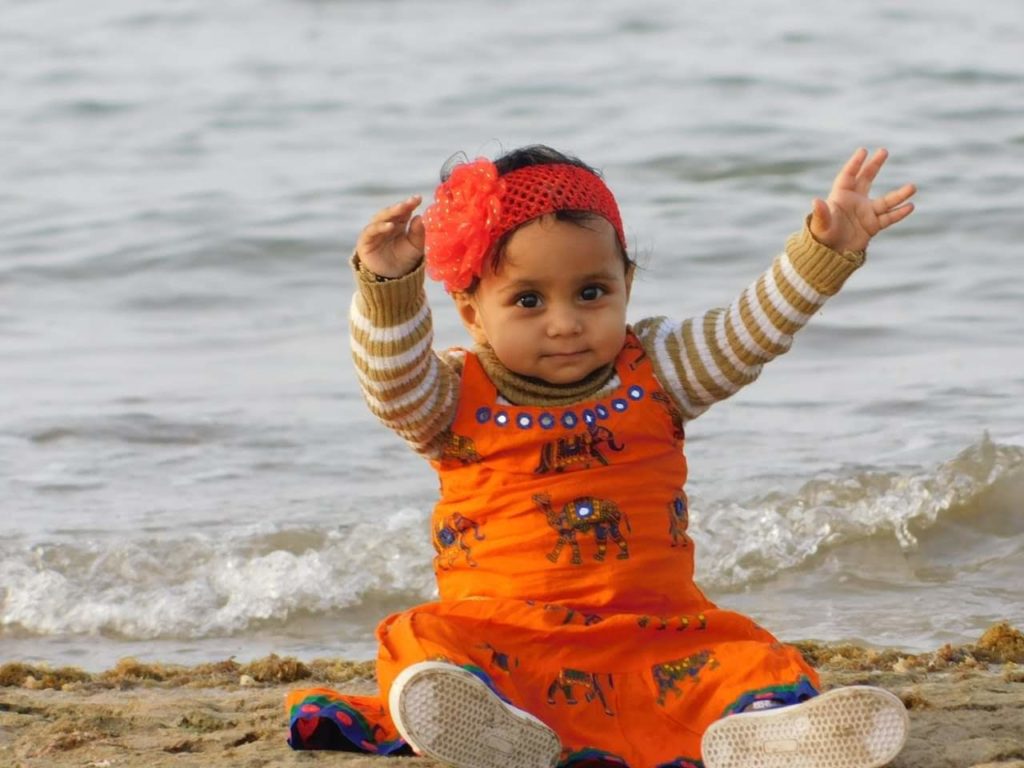Milestones in child development
Reference- Right from the start (Mandira Kumar)
A child’s abilities develop in a particular order, one upon the other, like building blocks.
The milestones listed here outline the behaviours and skills that children typically display by these ages. However, each child is unique and progresses at her own pace, depending on the opportunities and stimulation she receives. The roadmap of development is only indicative; it should not be used as a diagnostic tool as there are large variations in achieving milestones even among “normal” children.
THE INFANT (BIRTH -1 YEAR )
3 MONTHS Milestones in child development
- PHYSICAL DEVELOPMENT
- When lying on tummy…
- Pushes up on arms and tries to lift head up.
(b) COMMUNICATION AND SOCIAL SKILLS
- Looks
alert and interactive.
- Smiles
when smiled at.
- Maintains eye contact.
- Recognises mother.
- Turns head towards sound.
- Coos* and gurgles.
- Smiles
when smiled at.
PLAY AND COGNITION
When lying on back….
Keeps head in the middle to watch faces or toys.
Reaches for a toy held above the chest.
Turns head from side to side follow a moving toy.
Brings hands and fingers together .
Puts hands in mouth.
Bats at objects.
6 MONTHS
PHYSICAL DEVELOPMENT
Rolls over from back to tummy.
Sits with hand support.
COMMUNICATION AND SOCIAL SKILLS
Imitates sounds and laughs.
Babbles*(e.g., ’baba sounds).
PLAY AND COGNITION
When lying on back ….
Kicks legs and plays with feet.
Transfers a toy from one hand to the other .
Puts toys in mouth.
When lying on tummy…..
Reaches for a nearby toy.
9 MONTHS

PHYSICAL DEVELOPMENT
Sits without falling and reaches for toys.
Crawls on hands and knees.
COMMUNICATION AND SOCIAL SKILLS
Babbling gets more elaborate (e.g. ,’ babababa ).
Responds when called by name .
Begins to imitate social gestures such as waving ‘bye bye ‘.
Develops strong attachment to caregivers.
Feels wary of strangers .
PLAY AND COGNITION
Bangs and shakes toys.
Looks for a toy that has fallen out of sight.
Enjoys first social game of peekaboo*.
Imitates others in simple play.
12 MONTHS

PHYSICAL DEVELOPMENT
Uses pincer grasp* to pick up tiny objects.
Pulls to stand and cruises* around furniture.
Stands independent steps.
COMMUNICATION AND SOCIAL SKILLS
Understands simple words.
Follows 1-step instructions , e.g. , ‘come here!’
Understands ‘ NO!’
Looks for familiar family member when named.
Starts making long strings of sound or jargoning*.
Says first words .
Experiences separation anxiety*.
Begins to finger feed self.
Points to ask for something.
PLAY AND COGNITION
Understands cause – and – effect.
Drops objects into a container.
Looks at simple pictures in a book.
THE INFANT (BIRTH 1 -2YEARS )
15 MONTHS
PHYSICAL DEVELOPMENT
Creeps up stairs.
Walks independently and seldom falls.
COMMUNICATION AND SOCIAL SKILLS
Says about 3 -5 words.
Can point to a body part or toy.
Points to draw an adult’s attention to something.
Starts drinking from a cup.
PLAY AND COGNITION
Solitary play.
Uses both hands while playing.
Stacks two blocks.
18 MONTHS
PHYSICAL DEVELOPMENT
Walks smoothly with good balance.
Runs stiff – legged.
Climbs a ball while sitting, and learns to fling it.
COMMUNICATION AND SOCIAL SKILLS
Understands about 50 words.
Has a vocabulary of 10 – 25 words.
Says “ giant ” words such as ‘ thank you ‘.
Uses a spoon.
PLAY AND COGNITION
Scribbles spontaneously.
Builds a tower of 3 – 4 blocks .
Matches pairs of objects.
Looks at pictures when they are named .
Plays toys in simple pretend play*.
THE PRESCHOOLER (2 – 4 YEARS )
2 YEARS
PHYSICAL DEVELOPMENT
Squats and returns to standing.
Runs without falling down.
Walks up and down stairs placing both feet on each step, and using the railing for support.
COMMUNICATION AND SOCIAL SKILLS
Says about 50 words.
Joins 2- 3 words to make sentences.
Removes loose clothes and socks.
Follows 2 – step commands.
PLAY AND COGNITION
Imitates more complex actions .
Pretend play with two actions, such as bathing and feeding a doll.
Parallel play – plays alongside other children.
Begins to sort objects.
Builds a tower of 6 -7 blocks.
Matches objects to pictures.
Completes a simple 3 – shape puzzle.
Looks at detailed pictures.
3 YEARS
PHYSICAL DEVELOPMENT
Kicks a large stationary ball.
Throws a ball a few feet away.
Walks up stairs with alternating feet.
Jumps from a step.
COMMUNICATION AND SOCIAL SKILLS
Names most everyday objects and body parts.
Talks in sentences most of the time. Speaks in 3 – 5 words sentences using about 200 words.
Interacts with adults and children.
Begins to share and show concern towards others.
Begins to make friends.
PLAY AND COGNITION
Begins to play cooperatively, in small groups.
Listens to music or stories for 5 – 10 minutes .
Builds a tower of 9 – 10 blocks.
Strings beads.
Tries to draw a face .
Pretend play gets more complex, as roles are enacted and props used.
4 YEARS
PHYSICAL DEVELOPMENT
Catches a large ball with both hands.
Runs smoothly.
Jumps, using arms.
Walks up and down stairs with alternating feet.
Pedals and steers a tricycle.
Learns to swing on a swing.
Snips paper with scissors.
COMMUNICATION AND SOCIAL SKILLS
Has simple conversations about past and present experiences.
Speech can be easily understood by others.
Can take turns and share.
Asks lots of questions.
Dresses and undresses with help.
PLAY AND COGNITION
Begins to play cooperatively , in small groups .
Listens to music or stories for 5 – 10 minutes.
Builds a tower of 9 – 10 blocks.
Strings beads.
Tries to draw a face.
Pretend play gets more complex, as roles are enacted and props used.
Identifies colours.
Holds a crayon or pencil properly.
Builds playthings with several pieces.
Draws a person with three or more body parts.
As children advance through the early years, their language and thinking get more complex. Pre-schoolers need a wider range of playthings and activities it keep them absorbed, and companions to play with.